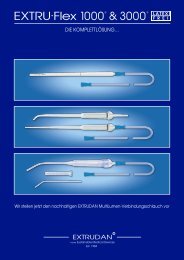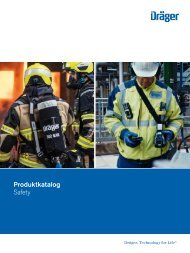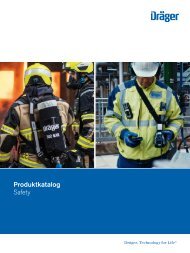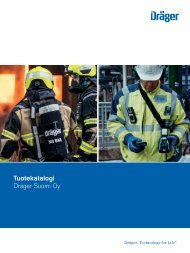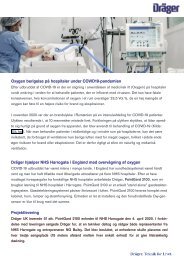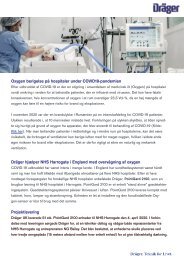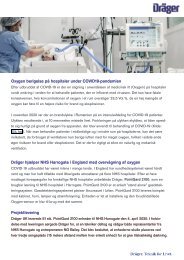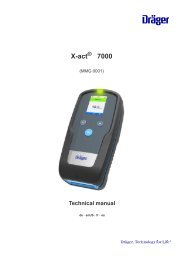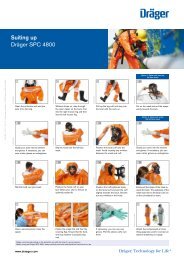Dräger Technology Insight - Protective Ventilation
Protective ventilation in the OR creates significant demands towards the anaesthesia workstation. Dräger works closely together with clinicians around the world to understand the needs and requirements for protective ventilation in the OR. This ebook describes the latest ventilator technologies deployed in our latest anaesthesia workstations, enabling successful protective ventilation strategies.
Protective ventilation in the OR creates significant demands towards
the anaesthesia workstation. Dräger works closely together with
clinicians around the world to understand the needs and requirements
for protective ventilation in the OR.
This ebook describes the latest ventilator technologies deployed in
our latest anaesthesia workstations, enabling successful protective
ventilation strategies.
Create successful ePaper yourself
Turn your PDF publications into a flip-book with our unique Google optimized e-Paper software.
KAPITEL | UNTERKAPITEL | 01<br />
<strong>Technology</strong> <strong>Insight</strong><br />
<strong>Protective</strong> ventilation in the OR creates significant demands towards<br />
the anaesthesia workstation. <strong>Dräger</strong> works closely together with<br />
clinicians around the world to understand the needs and requirements<br />
for protective ventilation in the OR.<br />
This ebook describes the latest ventilator technologies deployed in<br />
our latest anaesthesia workstations, enabling successful protective<br />
ventilation strategies.<br />
DL-18812-2014<br />
CLINICAL REQUIREMENTS<br />
OF AN ANAESTHESIA VENTILATOR<br />
<strong>Dräger</strong> is continuously monitoring the trends in clinical<br />
routine and clinical research. When designing therapy<br />
devices, patient protection and positively influencing<br />
clinical outcome is <strong>Dräger</strong>‘s mission.<br />
One important trend clearly shows that the clinical<br />
requirements for ventilation in the Operating Room<br />
have changed significantly over time, in order to improve<br />
outcome. For decades, bellows-driven ventilators have<br />
been the standard in anaesthesia.<br />
Given the variety of patients who require anaesthesia for<br />
surgery today (e.g. multimorbid patients, ICU patients,<br />
obese patients, neonates…), the performance demands<br />
for the anaesthesia ventilator have increased significantly,<br />
compared to the traditional performance of bellows-driven<br />
ventilators. Since clinicians expect to deliver anaesthesia<br />
gases while ventilating their patients with ICU-like quality,<br />
it was <strong>Dräger</strong>’s motivation for redesigning anaesthesia<br />
ventilators and breathing systems accordingly, introducing<br />
electronically driven ventilators to replace the traditional<br />
bellow-driven ventilators.<br />
TODAY’S REQUIREMENTS FOR VENTILATION IN<br />
PERIOPERATIVE AND INTENSIVE CARE MEDICINE<br />
COMPRISE:<br />
<strong>Ventilation</strong> Performance<br />
––<br />
Precise and stable pressures in controlled ventilation<br />
––<br />
Accurate and stable volume delivery in volume controlled<br />
ventilation<br />
––<br />
Fast and sensitive trigger response<br />
––<br />
Reduced Work-of-Breathing for spontaneously breathing<br />
patients<br />
Safety and Ease-of-Use Aspects<br />
––<br />
Rapid start-up procedure for emergency cases<br />
––<br />
Easy handling of parts in contact with patient gas during<br />
the reprocessing procedure<br />
––<br />
Safe and easy handling in case of gas supply failures<br />
TWO TECHNOLOGIES ARE CURRENTLY IN USE<br />
1) E-Vent* / E-Vent plus (piston driven technology)<br />
2) TurboVent** / TurboVent 2 (blower driven technology)<br />
*Electronic ventilator<br />
**Turbine driven ventilator
02 |<br />
TECHNOLOGY INSIGHT | E-VENT AND E-VENT PLUS<br />
E-Vent and E-Vent plus<br />
PISTON VENTILATOR TECHNOLOGY FROM DRÄGER<br />
The electrically driven piston ventilator E-Vent was<br />
introduced in 1990’s with the first Fabius® anaesthesia<br />
device. It is based on the proven design of the predecessor<br />
generation of electronically controlled piston<br />
ventilators, the DIVAN ventilator in the Cicero/Cato<br />
anaesthesia devices.<br />
Today, the E-Vent ventilator is used in the complete Fabius®<br />
product line and the further optimized E-Vent plus ventilator<br />
in the Primus® product family. The main difference between<br />
these 2 ventilators is the performance level of the system;<br />
e.g. with regard to the trigger sensitivity and the available<br />
ventilation modes.<br />
The piston ventilator has a built-in safety system enabling<br />
safe and accurate tidal-volume delivery and operation in<br />
low- and minimal-flow anaesthesia. In addition its operation<br />
is independent from any driving gas.<br />
Technical operating principle of piston ventilator<br />
The general operation principle is the same for both, E-Vent<br />
and E-Vent plus. The piston ventilator is electrically driven<br />
and electronically controlled. This results in unmatched<br />
accuracy, allowing for cost effective ICU level ventilation.<br />
First, the piston moves downwards. This is realized by a<br />
high precision electrically driven motor (1) and a ventilator<br />
spindle. This movement pulls in volume from the breathing<br />
system (3). To transfer the gas mixture from inside the<br />
piston (4) towards the patient, the piston then moves<br />
upwards – transferring the volume into the breathing circuit<br />
towards the patient.<br />
3<br />
the volume delivered by the piston is directly related<br />
to the linear movement of the piston (2). This makes the<br />
tidal volume delivery extremely accurate – and even in the<br />
unlikely event of a flow-sensor failure, ventilation with set<br />
volume delivery is still functioning. When the user sets a<br />
volume for ventilating the patient, the piston moves the<br />
distance necessary to deliver the required volume (4) into<br />
the breathing system (3). Furthermore, since the connection<br />
between piston and motor (1) is rigid, the position of the<br />
piston (2) is always identified and the volume delivered by<br />
the piston is, hence, always known.<br />
Compliance Compensation<br />
Irrespective of the type of ventilator being used, the volume<br />
delivered into the breathing circuit and the volume the<br />
patient receives are not identical. One major determinant of<br />
the difference between the two volumes is the compliance<br />
of the breathing system. As the ventilator delivers gas to<br />
the circuit, the pressure increases. The increased pressure<br />
compresses the gas in the system and also expands the<br />
circuit tubing, therefore reducing the volume that reaches<br />
the patient. Every breathing circuit has a certain compliance<br />
factor which defines the amount of volume stored in the<br />
circuit for a given change in pressure. Without means<br />
of compensating for the effect of circuit compliance,<br />
the volume the patient receives will decrease as pressure<br />
in the circuit increases.<br />
Advanced piston ventilator designs are able to compensate<br />
for the compliance of the breathing system by delivering<br />
sufficient additional volume with each breath to ensure<br />
that the patient receives the volume set to be delivered.<br />
<strong>Dräger</strong>’s piston ventilators measure the compliance of the<br />
system during the start-up self-test procedure. Once the<br />
compliance factor is determined, only a pressure sensor is<br />
required to calculate how much additional volume should<br />
be delivered with each breath to compensate for the loss<br />
due to the breathing system compliance. As a result,<br />
the set tidal volume is delivered to the patient’s airway.<br />
4<br />
1 <strong>Ventilation</strong> motor<br />
2 Ventilator piston<br />
3 Breathing system<br />
4 <strong>Ventilation</strong> chamber<br />
1<br />
2<br />
Schematic of E-Vent ventilator Primus<br />
ACCURATE TIDAL-VOLUME DELIVERY<br />
The most common ventilation mode in anaesthesia is<br />
volume-controlled ventilation. The clinician sets a tidal<br />
volume to be delivered to the patient. The piston ventilator<br />
design is uniquely suited to deliver this tidal volume<br />
accurately. Since the surface area of the piston is fixed,<br />
Gas Flow Diagram Primus®
03 |<br />
TECHNOLOGY INSIGHT | TURBOVENT AND TURBOVENT 2<br />
TurboVent and TurboVent 2<br />
BLOWER-DRIVEN VENTILATOR TECHNOLOGY<br />
FROM DRÄGER<br />
TurboVent was introduced as a ventilator in an anaesthesia<br />
machine with the Zeus® system in 2004. Prior to that, this<br />
technological principle had only been used in Intensive<br />
Care ventilators.<br />
To understand the operating principle, one can think<br />
of a hair dryer. It draws in ambient air, heats it up and<br />
accelerates it in one direction.<br />
The TurboVent ventilator works in a very similar way, just<br />
without heating. Through the one-directional rotation of an<br />
impeller (1), a gas mixture is sucked in from the reservoir<br />
bag in the breathing system (through 2), gets compressed<br />
(1 and 3), and it is then emitted towards the patient (4).<br />
2<br />
4<br />
This ventilator is also one of the core components of<br />
the Perseus® A500 anaesthesia workstation, brought to<br />
the market in 2012. Designed to fit perfectly into the<br />
breathing system, the TurboVent 2 ventilator achieves<br />
quick gas change and features a new ventilation mode in<br />
perioperative care: Airway Pressure Release <strong>Ventilation</strong><br />
(APRV).<br />
CONTINUOUS POSITIVE AIRWAY PRESSURE (CPAP)<br />
Continuous Positive Airway Pressure is a ventilation mode<br />
where the ventilator establishes and maintains the set<br />
pressure level in the patient lung for patients breathing<br />
spontaneously without any additional support from the<br />
ventilator, just utilizing the circular flow of the TurboVent2<br />
ventilator.<br />
The TurboVent2 ventilator is designed to reach changing<br />
pressure levels quickly and maintain pressures – which<br />
is especially important for the application of CPAP. With<br />
the Perseus® A500 and the Zeus® IE, CPAP can either be<br />
activated in MAN/SPONT mode or in Pressure Support<br />
mode.<br />
1<br />
3<br />
If a CPAP value (in MAN/SPONT mode) or a PEEP value<br />
(in controlled and supported ventilation modes) is set,<br />
the ventilator will use the circular flow, controlled by the<br />
PEEP/Pmax valve in the expiratory line to actively reach and<br />
maintain the CPAP level. This continuous pressure level is<br />
especially important for spontaneously breathing patients<br />
as well as for protective ventilation strategies when the<br />
maintenance of PEEP is important.<br />
Schematic of TurboVent ventilator<br />
In MAN/SPONT mode it is important that the APL valve is<br />
set to the appropriate position (SPON or below the CPAP<br />
level) allowing the patient to exhale without any additional<br />
resistance.<br />
Quick responses to spontaneous breathing efforts of<br />
the patient as well as the ability to reach pressure levels<br />
quickly and hold them actively are important attributes of<br />
this ventilator technology. The ventilator is allowing for<br />
spontaneous breathing during ventilation at any time and<br />
allows for a Work-of-Breathing as low as in ICU ventilators.<br />
With the introduction of the 2nd generation of this ventilator<br />
(TurboVent 2) as part of the Zeus® Infinity® Empowered<br />
in 2009, <strong>Dräger</strong> even improved the turbine design with<br />
regards to better handling for infection prevention and<br />
maintenance efficiency, making it easy to detach from<br />
the breathing system and dismantle for cleaning and<br />
sterilization.<br />
Gas Flow Diagram Zeus® Infinity® Empowered
04 |<br />
TECHNOLOGY INSIGHT<br />
Not all products, features, or services are for sale in all countries.<br />
6643 | 16.08-2 | BM | PR | Subject to modifications | © 2016 <strong>Dräger</strong>werk AG & Co. KGaA<br />
CORPORATE HEADQUARTERS<br />
<strong>Dräger</strong>werk AG & Co. KGaA<br />
Moislinger Allee 53–55<br />
23558 Lübeck, Germany<br />
www.draeger.com<br />
Manufacturer:<br />
<strong>Dräger</strong>werk AG & Co. KGaA<br />
Moislinger Allee 53–55<br />
23558 Lübeck, Germany<br />
REGION DACH<br />
<strong>Dräger</strong>werk AG & Co. KGaA<br />
Moislinger Allee 53–55<br />
23558 Lübeck, Germany<br />
Tel +49 451 882 0<br />
Fax +49 451 882 2080<br />
info@draeger.com<br />
REGION EUROPE<br />
<strong>Dräger</strong>werk AG & Co. KGaA<br />
Moislinger Allee 53–55<br />
23558 Lübeck, Germany<br />
Tel +49 451 882 0<br />
Fax +49 451 882 2080<br />
info@draeger.com<br />
REGION MIDDLE EAST, AFRICA<br />
<strong>Dräger</strong>werk AG & Co. KGaA<br />
Branch Office<br />
P.O. Box 505108<br />
Dubai, United Arab Emirates<br />
Tel +971 4 4294 600<br />
Fax +971 4 4294 699<br />
contactuae@draeger.com<br />
REGION ASIA/PACIFIC<br />
Draeger Medical<br />
South East Asia Pte Ltd.<br />
25 International Business Park<br />
#04-27/29 German Centre<br />
Singapore 609916, Singapore<br />
Tel +65 6572 4388<br />
Fax +65 6572 4399<br />
asia.pacific@draeger.com<br />
REGION CENTRAL AND SOUTH<br />
AMERICA<br />
<strong>Dräger</strong> Panama Comercial<br />
S. de R.L.<br />
Complejo Business Park,<br />
V tower, 10th floor<br />
Panama City<br />
Tel +507 377 9100<br />
Fax +507 377 9130<br />
contactcsa@draeger.com<br />
Locate your Regional Sales<br />
Representative at:<br />
www.draeger.com/contact




